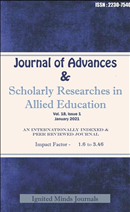Numerical Solution: A Study of Partially Differential Equation
Keywords:
Partial differential equations, Numerical methods, SolutionAbstract
This study explores various numerical methods for solving partial differential equations (PDEs), which are crucial in modeling complex phenomena across diverse scientific and engineering fields. Given the challenges associated with obtaining analytical solutions for PDEs, numerical approaches such as the Finite Difference Method (FDM), Finite Element Method (FEM), and Finite Volume Method (FVM) have become essential. This research provides a comparative analysis of these techniques, evaluating them based on accuracy, computational efficiency, and applicability to different types of PDEs, including elliptic, parabolic, and hyperbolic equations. Through a series of test cases, the study highlights the strengths and weaknesses of each method, offering practical insights into their use for solving PDEs in real-world scenarios.
Downloads
References
Agyeman,E.,Folson,D., International Journal of Computer Applications, 79(5), 11, 2013.
Dr. Grewal, Ninth edition numerical methods in engineering and science, with programs in c and c++, published by: Romesh Chander Khan na , 2-B nath market, NaiSarak Delhi, (2013) .
H. S´eka and K. R. Assui. Order of the Runge-Kutta method and evolution of the stability region. Ural Mathematical Journal, 5(2):64–71, 2019.
Islam, Md.A. (2015) Accurate Solutions of Initial Value Problems for Ordinary Differential Equations with Fourth Order Runge Kutta Method. Journal of Mathematics Research, 7, 41-45. http://dx.doi.org/10.5539/jmr.v7n3p41
Liu, T., International Journal of Hybrid Information Techonology, 8(8),91, 2015.
Meher R., Mehta M. N. and. Meher S. K., Adomian decomposition method for moisture content in one dimensional fluid flow through unsaturated porous media, International Journal of Applied Mathematics and mechanics, 6 (7), 13 – 23, 2010.
Mehta M. N. and Yadav S., Classical solution of Non-linear Equations arising in fluid flow through Homogenous Porous Media, 2009.
Patel H. S., Meher R., Modelling of imbibition phenomena in fluid flow through heterogeneous inclined porous media with different porous materials, Nonlinear Engineering, 6(4), 263 – 275, 2017.
Shah D. A., Parikh A. K., Classical Solution of Non-stationary Heat Equation with Nonlinear Logarithmic Source Using Generalized Functional Separable Method (GFSM), Journal of Computer and Mathematical Sciences (An International research Journal), 9(10), 1301 – 1306, 2018.
Summiya Parveen, “Numerical Solution of Non Linear Differential Equation By Using Shooting Technique”, International Journal of Mathematics And its Application, Volume 4, Issue 1-A(2016), 93-100 ISSN: 2347-1557.
Swaroop A., and Mehta M. N., A Solution to the problem of one- dimensional flow in unsaturated porous media taking Finite Element Approach, Proceeding of International conference on Mathematical modeling, Jan-29-31, 141 – 143, 2001.
W.Y. Yang, W. Cao, J. Kim, K. W. Park, H. H. Park, J. Joung, J. S. Ro, H. L. Lee, C. H. Hong, and T. Im. Applied numerical methods using MATLAB. John Wiley & Sons, 2020.
Wusu, S. A. Akanbi, M. A. and Okunuga. S. A. A three-stage multiderivative explicit Runge-Kutta method. American Journal of Computational Mathemat- ics, 3(2):121–126, 2013.











